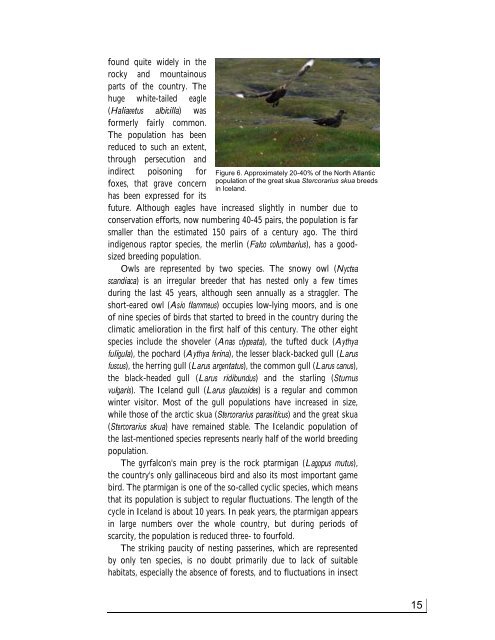BIOLOGICAL DIVERSITY IN ICELAND - Convention on Biological ...
BIOLOGICAL DIVERSITY IN ICELAND - Convention on Biological ...
BIOLOGICAL DIVERSITY IN ICELAND - Convention on Biological ...
- No tags were found...
Create successful ePaper yourself
Turn your PDF publications into a flip-book with our unique Google optimized e-Paper software.
found quite widely in therocky and mountainousparts of the country. Thehuge white-tailed eagle(Haliaeetus albicilla) wasformerly fairly comm<strong>on</strong>.The populati<strong>on</strong> has beenreduced to such an extent,through persecuti<strong>on</strong> andindirect pois<strong>on</strong>ing forfoxes, that grave c<strong>on</strong>cernhas been expressed for itsFigure 6. Approximately 20-40% of the North Atlanticpopulati<strong>on</strong> of the great skua Stercorarius skua breedsin Iceland.future. Although eagles have increased slightly in number due toc<strong>on</strong>servati<strong>on</strong> efforts, now numbering 40-45 pairs, the populati<strong>on</strong> is farsmaller than the estimated 150 pairs of a century ago. The thirdindigenous raptor species, the merlin (Falco columbarius), has a goodsizedbreeding populati<strong>on</strong>.Owls are represented by two species. The snowy owl (Nycteascandiaca) is an irregular breeder that has nested <strong>on</strong>ly a few timesduring the last 45 years, although seen annually as a straggler. Theshort-eared owl (Asio flammeus) occupies low-lying moors, and is <strong>on</strong>eof nine species of birds that started to breed in the country during theclimatic ameliorati<strong>on</strong> in the first half of this century. The other eightspecies include the shoveler (Anas clypeata), the tufted duck (Aythyafuligula), the pochard (Aythya ferina), the lesser black-backed gull (Larusfuscus), the herring gull (Larus argentatus), the comm<strong>on</strong> gull (Larus canus),the black-headed gull (Larus ridibundus) and the starling (Sturnusvulgaris). The Iceland gull (Larus glaucoides) is a regular and comm<strong>on</strong>winter visitor. Most of the gull populati<strong>on</strong>s have increased in size,while those of the arctic skua (Stercorarius parasiticus) and the great skua(Stercorarius skua) have remained stable. The Icelandic populati<strong>on</strong> ofthe last-menti<strong>on</strong>ed species represents nearly half of the world breedingpopulati<strong>on</strong>.The gyrfalc<strong>on</strong>'s main prey is the rock ptarmigan (Lagopus mutus),the country's <strong>on</strong>ly gallinaceous bird and also its most important gamebird. The ptarmigan is <strong>on</strong>e of the so-called cyclic species, which meansthat its populati<strong>on</strong> is subject to regular fluctuati<strong>on</strong>s. The length of thecycle in Iceland is about 10 years. In peak years, the ptarmigan appearsin large numbers over the whole country, but during periods ofscarcity, the populati<strong>on</strong> is reduced three- to fourfold.The striking paucity of nesting passerines, which are representedby <strong>on</strong>ly ten species, is no doubt primarily due to lack of suitablehabitats, especially the absence of forests, and to fluctuati<strong>on</strong>s in insect15
















